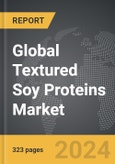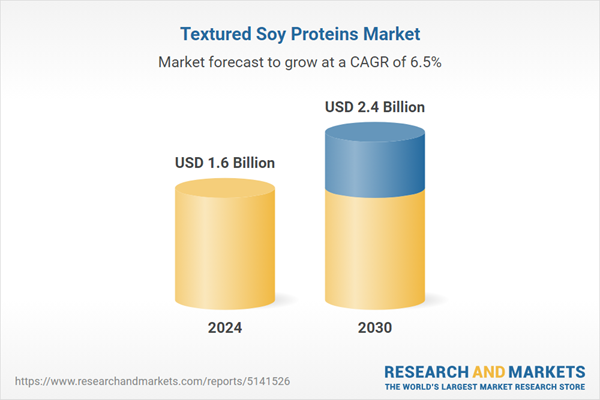The global market for Textured Soy Proteins was valued at US$1.6 Billion in 2024 and is projected to reach US$2.4 Billion by 2030, growing at a CAGR of 6.5% from 2024 to 2030. This comprehensive report provides an in-depth analysis of market trends, drivers, and forecasts, helping you make informed business decisions. The report includes the most recent global tariff developments and how they impact the Textured Soy Proteins market.
Segments: Type (Conventional, Non-GMO, Organic); Source (Soy Protein Isolates, Soy Protein Concentrates, Soy Flour); Application (Food, Feed).
Geographic Regions/Countries: World; United States; Canada; Japan; China; Europe (France; Germany; Italy; United Kingdom; Spain; Russia; and Rest of Europe); Asia-Pacific (Australia; India; South Korea; and Rest of Asia-Pacific); Latin America (Argentina; Brazil; Mexico; and Rest of Latin America); Middle East (Iran; Israel; Saudi Arabia; United Arab Emirates; and Rest of Middle East); and Africa.
The analysts continuously track trade developments worldwide, drawing insights from leading global economists and over 200 industry and policy institutions, including think tanks, trade organizations, and national economic advisory bodies. This intelligence is integrated into forecasting models to provide timely, data-driven analysis of emerging risks and opportunities.
Global Textured Soy Proteins Market - Key Trends and Drivers Summarized
Why Are Textured Soy Proteins Becoming Popular?
Textured soy proteins (TSP), also known as textured vegetable proteins, are gaining widespread popularity as a high-protein, low-fat, plant-based meat substitute. Made from defatted soy flour, TSP is processed into a fibrous, chewy texture that resembles meat, making it an ideal ingredient for vegetarian and vegan products. As consumer demand for plant-based foods continues to rise, textured soy proteins are being used in a variety of meat substitutes, including burgers, sausages, and ground meat alternatives. With growing awareness of health benefits, such as lower cholesterol and reduced fat content, alongside the environmental advantages of plant-based diets, TSP is becoming a key ingredient in the food industry’s shift toward sustainable food production.How Are Textured Soy Proteins Used in Different Food Products?
Textured soy proteins are widely used in the food industry as an affordable, versatile alternative to meat. Food manufacturers use TSP in products such as veggie burgers, sausages, tacos, and chili, where it mimics the texture and appearance of ground meat. Additionally, TSP is used as an ingredient in ready-to-eat meals and snacks, where its high protein content makes it a nutritious addition. The foodservice industry, including restaurants and fast-food chains, is also incorporating TSP into their menus to cater to the growing number of consumers seeking plant-based options. As the market for vegan and vegetarian products continues to grow, TSP is becoming a central component of innovative food formulations.What Segments Drive the Textured Soy Protein Market?
Product types include concentrates, isolates, and flour, with soy protein concentrates being the most widely used due to their high protein content and versatility. Applications include meat substitutes, ready-to-eat meals, and snacks, with the meat substitute segment holding the largest share. Distribution channels range from supermarkets and health food stores to online retail platforms. Geographically, North America and Europe dominate the market, driven by high consumer awareness and demand for plant-based proteins. However, the Asia-Pacific region is emerging as a key market due to rising disposable incomes, expanding food processing industries, and increasing interest in plant-based diets.The Growth in the Textured Soy Protein Market Is Driven by Several Factors
The growth in the textured soy protein market is driven by several factors, including the rising demand for plant-based proteins, increasing awareness of the health benefits of soy products, and the shift toward sustainable food production. As consumers become more health-conscious and environmentally aware, they are seeking alternatives to animal-based proteins, leading to a surge in demand for TSP in meat substitutes. The expansion of the vegan and vegetarian market, along with advancements in food processing technologies that improve the texture and flavor of TSP-based products, is further fueling market growth. Additionally, the growing adoption of TSP in emerging markets, coupled with the expansion of distribution channels, is expected to drive continued growth in the textured soy protein market.Report Scope
The report analyzes the Textured Soy Proteins market, presented in terms of units. The analysis covers the key segments and geographic regions outlined below.Segments: Type (Conventional, Non-GMO, Organic); Source (Soy Protein Isolates, Soy Protein Concentrates, Soy Flour); Application (Food, Feed).
Geographic Regions/Countries: World; United States; Canada; Japan; China; Europe (France; Germany; Italy; United Kingdom; Spain; Russia; and Rest of Europe); Asia-Pacific (Australia; India; South Korea; and Rest of Asia-Pacific); Latin America (Argentina; Brazil; Mexico; and Rest of Latin America); Middle East (Iran; Israel; Saudi Arabia; United Arab Emirates; and Rest of Middle East); and Africa.
Key Insights:
- Market Growth: Understand the significant growth trajectory of the Conventional segment, which is expected to reach US$914.4 Million by 2030 with a CAGR of a 4.3%. The Non-GMO segment is also set to grow at 6.8% CAGR over the analysis period.
- Regional Analysis: Gain insights into the U.S. market, valued at $422.6 Million in 2024, and China, forecasted to grow at an impressive 10.6% CAGR to reach $559.6 Million by 2030. Discover growth trends in other key regions, including Japan, Canada, Germany, and the Asia-Pacific.
Why You Should Buy This Report:
- Detailed Market Analysis: Access a thorough analysis of the Global Textured Soy Proteins Market, covering all major geographic regions and market segments.
- Competitive Insights: Get an overview of the competitive landscape, including the market presence of major players across different geographies.
- Future Trends and Drivers: Understand the key trends and drivers shaping the future of the Global Textured Soy Proteins Market.
- Actionable Insights: Benefit from actionable insights that can help you identify new revenue opportunities and make strategic business decisions.
Key Questions Answered:
- How is the Global Textured Soy Proteins Market expected to evolve by 2030?
- What are the main drivers and restraints affecting the market?
- Which market segments will grow the most over the forecast period?
- How will market shares for different regions and segments change by 2030?
- Who are the leading players in the market, and what are their prospects?
Report Features:
- Comprehensive Market Data: Independent analysis of annual sales and market forecasts in US$ Million from 2024 to 2030.
- In-Depth Regional Analysis: Detailed insights into key markets, including the U.S., China, Japan, Canada, Europe, Asia-Pacific, Latin America, Middle East, and Africa.
- Company Profiles: Coverage of players such as Archer Daniels Midland Company, Bremil Group, Cargill, Inc., Crown Soya Protein Group, Dow, Inc. and more.
- Complimentary Updates: Receive free report updates for one year to keep you informed of the latest market developments.
Some of the 42 companies featured in this Textured Soy Proteins market report include:
- Archer Daniels Midland Company
- Bremil Group
- Cargill, Inc.
- Crown Soya Protein Group
- Dow, Inc.
- DuPont de Nemours, Inc.
- DPS/Dutch Protein & Services B.V.
- Hung Yang Foods Co., Ltd.
- Linyi Shansong Biological Products Co., Ltd.
- Shandong Yuxin Bio-Tech Co., Ltd.
- Sonic Biochem Extraction Pvt., Ltd.
- Victoria Group A.D.
- Wilmar International Ltd.
Tariff Impact Analysis: Key Insights for 2025
Global tariff negotiations across 180+ countries are reshaping supply chains, costs, and competitiveness. This report reflects the latest developments as of April 2025 and incorporates forward-looking insights into the market outlook.The analysts continuously track trade developments worldwide, drawing insights from leading global economists and over 200 industry and policy institutions, including think tanks, trade organizations, and national economic advisory bodies. This intelligence is integrated into forecasting models to provide timely, data-driven analysis of emerging risks and opportunities.
What’s Included in This Edition:
- Tariff-adjusted market forecasts by region and segment
- Analysis of cost and supply chain implications by sourcing and trade exposure
- Strategic insights into geographic shifts
Buyers receive a free July 2025 update with:
- Finalized tariff impacts and new trade agreement effects
- Updated projections reflecting global sourcing and cost shifts
- Expanded country-specific coverage across the industry
Table of Contents
I. METHODOLOGYII. EXECUTIVE SUMMARY2. FOCUS ON SELECT PLAYERSIII. MARKET ANALYSISCANADAITALYSPAINRUSSIAREST OF EUROPESOUTH KOREAREST OF ASIA-PACIFICARGENTINABRAZILMEXICOREST OF LATIN AMERICAIRANISRAELSAUDI ARABIAUNITED ARAB EMIRATESREST OF MIDDLE EASTIV. COMPETITION
1. MARKET OVERVIEW
3. MARKET TRENDS & DRIVERS
4. GLOBAL MARKET PERSPECTIVE
UNITED STATES
JAPAN
CHINA
EUROPE
FRANCE
GERMANY
UNITED KINGDOM
ASIA-PACIFIC
AUSTRALIA
INDIA
LATIN AMERICA
MIDDLE EAST
AFRICA
Companies Mentioned (Partial List)
A selection of companies mentioned in this report includes, but is not limited to:
- Archer Daniels Midland Company
- Bremil Group
- Cargill, Inc.
- Crown Soya Protein Group
- Dow, Inc.
- DuPont de Nemours, Inc.
- DPS/Dutch Protein & Services B.V.
- Hung Yang Foods Co., Ltd.
- Linyi Shansong Biological Products Co., Ltd.
- Shandong Yuxin Bio-Tech Co., Ltd.
- Sonic Biochem Extraction Pvt., Ltd.
- Victoria Group A.D.
- Wilmar International Ltd.
Table Information
| Report Attribute | Details |
|---|---|
| No. of Pages | 323 |
| Published | April 2025 |
| Forecast Period | 2024 - 2030 |
| Estimated Market Value ( USD | $ 1.6 Billion |
| Forecasted Market Value ( USD | $ 2.4 Billion |
| Compound Annual Growth Rate | 6.5% |
| Regions Covered | Global |









